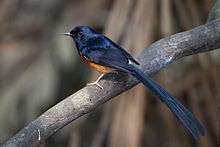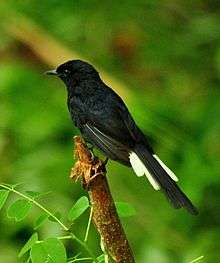Magpie-robin
The magpie-robins or shamas (from shama, Bengali and Hindi for C. malabaricus)[1] are medium-sized insectivorous birds (some also eat berries and other fruit) in the genus Copsychus. They were formerly in the thrush family Turdidae, but are now treated as part of the Old World flycatcher family Muscicapidae. They are garden- and forest-dwelling species found in Africa and Asia.
| Magpie-robins | |
|---|---|
 | |
| Male white-rumped shama (Copsychus malabaricus) | |
| Scientific classification | |
| Kingdom: | Animalia |
| Phylum: | Chordata |
| Class: | Aves |
| Order: | Passeriformes |
| Family: | Muscicapidae |
| Genus: | Copsychus Wagler, 1827 |
| Type species | |
| Copsychus saularis | |
| Species | |
|
see text | |
The genus Copsychus was introduced by the German naturalist Johann Georg Wagler in 1827.[2] The type species was subsequently designated as the Oriental magpie-robin (Copsychus saularis) by the English zoologist George Robert Gray in 1840.[3][4] The name Copsychus is from the Ancient Greek kopsukhos or kopsikhos, meaning "blackbird".[5]
The genus contains 12 species:[6]
| Image | Scientific name | Common name | Distribution |
|---|---|---|---|
 | Copsychus fulicatus | Indian robin | Bangladesh, Bhutan, India, Nepal, Pakistan and Sri Lanka |
 | Copsychus saularis | Oriental magpie-robin | Bangladesh, India, Sri Lanka, eastern Pakistan, eastern Indonesia, Thailand, southern China, Malaysia and Singapore |
| Copsychus pyrropygus | Rufous-tailed shama | southern Thailand, Malaysia, Sumatra and Borneo | |
| Copsychus albospecularis | Madagascan magpie-robin | Madagascar | |
 | Copsychus sechellarum | Seychelles magpie-robin | the Seychelles |
| Copsychus mindanensis | Philippine magpie-robin | the Philippines | |
 | Copsychus malabaricus | White-rumped shama | Malaysia |
| Copsychus albiventris | Andaman shama | the Andaman Islands | |
| Copsychus stricklandii | White-crowned shama | Borneo | |
| Copsychus luzoniensis | White-browed shama | the Philippines | |
 | Copsychus niger | White-vented shama | Palawan, Balabac and Calamian in the Philippines |
| Copsychus cebuensis | Black shama | Cebu in the Philippines | |
The Seychelles magpie-robin is one of the most endangered birds in the world, with a population of less than 250, although this is a notable increase from just 16 in 1970.
References
- Jobling, James A. (1991). A Dictionary of Scientific Bird Names. Oxford University Press. p. 216. ISBN 0-19-854634-3.
- Wagler, Johann Georg (1827). Systema avium (in Latin). Stuttgart: J.G. Cottae. p. 306 (Gracula).
- Gray, George Robert (1840). A List of the Genera of Birds : with an Indication of the Typical Species of Each Genus. London: R. and J.E. Taylor. p. 21.
- Mayr, Ernst; Paynter, Raymond A. Jr, eds. (1964). Check-list of Birds of the World. Volume 10. Cambridge, Massachusetts: Museum of Comparative Zoology. p. 64-65.
- Jobling, J.A. (2018). del Hoyo, J.; Elliott, A.; Sargatal, J.; Christie, D.A.; de Juana, E. (eds.). "Key to Scientific Names in Ornithology". Handbook of the Birds of the World Alive. Lynx Edicions. Retrieved 10 May 2018.
- Gill, Frank; Donsker, David (eds.). "Chats, Old World flycatchers". World Bird List Version 6.2. International Ornithologists' Union. Retrieved 20 May 2016.